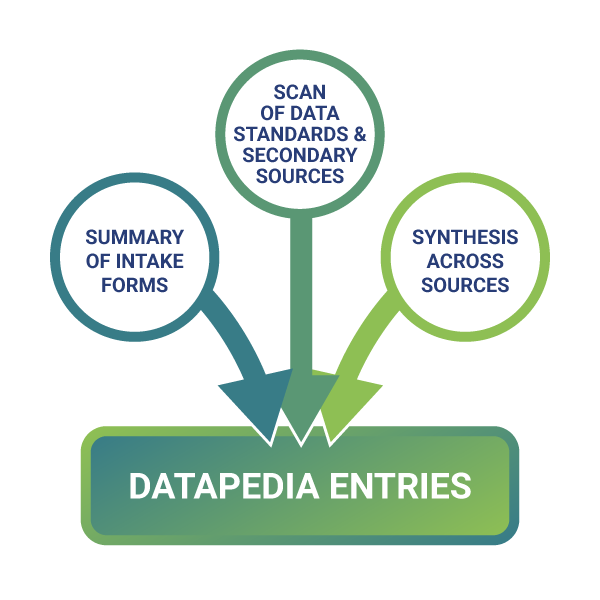Demographic Datapedia Entry:
Personal Identifying Information
Each datapedia entry begins with definition(s) of the demographic variable followed by some considerations and limitations of the variable for understanding populations of people.
Next, a suggested question(s) and response options are shown. Note that this is given as guidance rather than a prescription of what’s best as that will depend on the information needs and context of your organization. Also included are ideas and examples of how to ask questions about the demographic variable in conversation.
2.1 Definition
A. Personal identifying information refers to information that can most likely identify an individual through direct means, such as: name, social insurance number, healthcare number or indirect means, such as: date of birth, place of residence, or unique personal characteristics.2
2.2 Considerations and Limitations
Personal identifying information can be used to understand:
- Who is being served, e.g., demographic characteristics, geographical characteristics.
- Obtaining client contact details for follow-up.
- Determining clients’ eligibility for programs and providing referrals.
- How clients flow through programs within the organization and across similar or different organizations, through the use of a central database or data linkage.
Personal identifying information cannot be used to understand:
- Clients’ goals or reasons for seeking out the services.
- A client’s personal history or existing health or legal records, unless their permission was granted to do so.
Additional considerations:
- Try to follow the principle of collecting only the data need. PIPA states: “organizations can only collect personal information for reasonable purposes and to the extent reasonably needed for that purpose.”3
- It is useful to consider the scope of consent (i.e., what is the information being used for) and does the client understand how the data will be used? Most consent is sufficient for collecting personal information for providing services. Additional conversation and processes may be needed to use personal information for referrals, evaluation, or research. More details can found in the Plan section of the Data Lifecycle.
2.3 Suggested Collection Methods
The minimum suggested data collection method, or “basic” option reflects a synthesis of practices, considerations from nonprofit stakeholders, and recognized standards in capturing demographic data. The suggested method is modeled after what might be asked on an intake form during an initial meeting with a client. The process by which intake or registration occurs can vary widely depending on the context within which you are working. For example, the way questions are asked and data are recorded will vary for clients in crises, as compared to walk-in or drop-in sessions, or when registering for a program that requires people to meet certain eligibility requirements. In those cases, the suggested collection method can be used as a starting point but adapted to fit the needs of the context within which the data are being collected.
If your organization is planning to identify unique individuals across programs within the organization, or to eventually link to, or identify individuals across databases, make sure to collect at least first name, last name and date of birth as these are essential pieces of information to identify a unique individual.
2.3.1 Basic Question(s)
Note: The following questions are a list of possible questions that may be required by the organization. It is not required to ask all of these questions. The first four questions are extremely helpful to record to use in identifying unique clients and we recommend always capturing those, if possible.
1. What is your first name? ____________________
2. What is your last name? ____________________
3. What is your preferred name (if different from your first name)? ____________________
4. What is your date of birth? YYYY-MM-DD
5. What is your postal code? __ __ __ __ __ __
6. What is your email? __________________
7. What is your phone number? (###)-###-####
In conversation, the question may be phrased as:
- Would it be okay if I take down your name and date of birth for our records?
We use this information to be able to provide services to you.
We also use the information later to learn about people’s journeys so we can improve our services.

COLLECT
For considerations on building trust and relationships through data collection see the Collect section of the Data Lifecycle.


LENSES
You may wish to approach your data collection work through the lens of a particular framework or set of guiding principles, which will shape how you think about your response options. For more details, see the Lenses section of the Data Lifecycle.
To create the diagram for variable responses, two main sets of sources were used.
- Organization intake and registration forms from nonprofit subsectors across Alberta.
- Best practices in data collection, academic literature of demographic data, and resources from data aggregators (e.g., Statistics Canada, National Institutes of Health).
Findings from these sources were synthesized and organized across three levels of response options: basic, detailed, and comprehensive. To learn more please see the full methods. Datapedia Project Approach and Acknowledgements.pdf
Footnotes
Government of Alberta. (2019, September 23). Tri-Council Policy Statement: Ethical Conduct for Research Involving Humans – TCPS 2 (2018). https://ethics.gc.ca/eng/tcps2-eptc2_2018_chapter5-chapitre5.html#a
Government of Alberta. (n.d.). Collecting personal information. https://www.alberta.ca/collecting-personal-information.aspx.
Do you have additions to suggest to the Datapedia? Or, do you want to learn more about working with data?
We’d love to hear from you. Contact us at info@policywise.nickpetlock.com.



